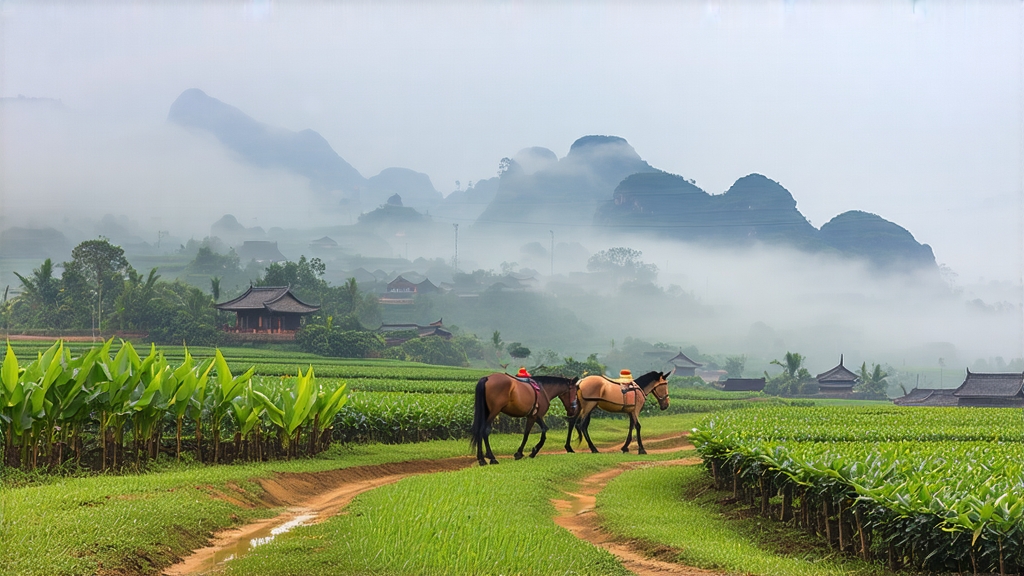
Tucked beneath the humid karst mountains of southern China, Liupu tea has spent three centuries quietly fermenting in terracotta jars, emerging as one of the most aromatic yet least understood members of the Hei Cha (dark tea) family. While Pu-erh commands global fame, Liupu remains the connoisseur’s whisper—an elixir once bartered for horses on the Tea-Horse Road and now sought by collectors who prize its camphor-cool sweetness and the mineral echo of limestone caves.
History: From Military Ration to Underground Treasure
The story begins in 1810, when tea merchants in Cangwu County, Guangxi, found that their coarse summer leaf, packed in straw-lined clay jars for the journey to Yunnan, had transformed during the torrid riverboat passage. The tea’s color darkened, its bitterness mellowed, and a cooling menthol note appeared—qualities that Qing-dynasty cavalry valued for settling stomachs after long rides. Imperial records of 1825 list “Liupu gong cha” as part of the military stipend, and by 1855 the tea was being pressed into 500 g bricks, stamped with the governor’s seal and stored in the natural refrigerators of local caves. Warlords, monks, and later Hong Kong tea merchants all contributed to a clandestine aging network; some 1950s vintages still surface at auction, their wrappers tattooed by decades of subterranean condensation.
Micro-Terroirs within Guangxi
Liupu is not a single township but a mosaic of micro-climates along the Liujiang and Xunjiang rivers. The core “three gorges” zone—Liupu, Shiqiao, and Dali—offers nightly mountain mists that slow oxidation, while the red lateritic soil loads leaf tips with ionized iron, deepening the liquor’s ruby hue. Farmers distinguish between shan cha (mountain bushes over 60 years old) and yuan cha (garden hedges on alluvial plains); the former yield fewer than 80 kg per mu yet develop the signature camphor-lotus aroma that collectors call “gui wei” (ghost note). Since 2008, a protected geographical indication restricts the name “Liupu” to leaf picked within Wuzhou and 12 adjacent towns, mirroring the French appellation system.
Craft: When Microbes Outnumber the Leaves
Harvest begins on Grain Rain day: one bud plus third or fourth leaf, lignified enough to feed the coming microbial feast. After a brief indoor withering, the leaves receive a 3-minute 280 °C pan-fire—longer than green tea, shorter than oolong—arresting oxidation while preserving pectins that later become fungal food. The still-hot leaf is piled 70 cm deep inside bamboo-lined chambers; misted to 28 % moisture, it enters the “wet piling” (wo dui) phase that defines all dark teas. Yet Liupu’s twist is the addition of “mother jar liquor,” a starter brewed from previous batches and local well water rich in Penicillium liupuensis, a species identified in 2017 by Guangxi University. Over 18 days the pile hits 58 °C twice; workers turn it with long teak rakes, timing flips to the drum of a wooden fish—one beat every 30 seconds—so that the microbes breathe in rhythm. Finally the tea is sun-dried on rattan trays for exactly 41 minutes, the interval needed to let surface moisture evaporate while trapping endo-bacteria that will continue aging inside the jar.
Subterranean Maturation: The Cave Phase
Unlike Pu-erh, which ages in airy warehouses, Liupu demands darkness and 88 % humidity. New tea is packed into unglazed Guangxi clay jars—breathable vessels whose 3 % porosity allows oxygen to enter at 0.2 ml per day. Jars are rolled on pine logs into limestone caves whose ambient temperature hovers at 19 °C year-round. There they rest for a minimum of five years; premium labels wait fifteen. During this time, actinomycetes weave white filaments across the leaf spine, metabolizing caffeine into theophylline and releasing a cool, almost eucalyptus-like aroma. Every spring, tea cave guardians (cha dong zi) sample by inserting a bamboo straw through a jar’s bung hole; if the liquor fails to display the “three reds and one gold